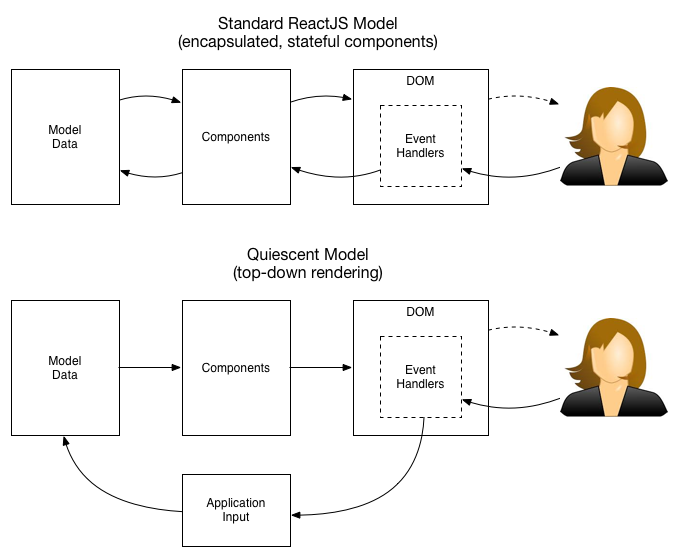Good questions.
Regarding the Hideable: Yes, if using only Quiescent components, Quiescent would require that the fact that the component is hidden or not be present in the value used to render the component. Note that it doesn't have to be simplistic as a {:hidden true} value, however; it is perfectly legitimate to have the renderer invoke view-specific code that decides whether an item is hidden or not based the value provided. For example, the TodoMVC example does exactly this with its filtering mechanism; the view state only specifies what filter is present, and the rendering code compares that with each item to see if it should be hidden or visible.
The same goes for a SortableTable; the current sort column and direction would need to be specified somehow in the value used to render. Note that in many cases, this is a good thing; it means it is possible to share and persist UI states across sessions (if you want).
The tradeoff is, of course, that it does make it more difficult to write a fully encapsulated UI widget that provides stateful functionality while remaining agnostic to its location. If you rely heavily on such components, Quiescent might not be the library for you. I can, however, think of several approaches:
- You could allocate a top-level slot in your application state data structure for the exclusive use of encapsulated widgets, and write your widgets against that.
- You can always write a component in raw ReactJS using interop, and drop it in to your render tree. Quiescent components render non-Quiescent child components just fine.
- Part of your widget's API could be to define mapping functions that specify how/where to store its internal state (via callback functions, perhaps.) This offloads some of the work on the consumer but maintains the full Quiescent application model.
Your final point is correct. In the Quiescent model, for a component to change anything, it (or, more precisely, a handler function that it defines) must somehow reach back out and update the higher-level state and cause a re-render. Exactly how that works is up to you; Quiescent specifically does not impose any particular technique there. You could pass in a cursor, a-la Om, or core.async channels, like I do in the TodoMVC application. (You could also swap an atom directly in the handler function. But ew, gross.)
My recommendation is that you think of your application's handler functions not as getters and setters for your applications state, but as inputs for your system:

om,reagentandReactwould recommend and allow you to implement a stateful component that can close over internal render only state.For example a
Hidablecomponent might implement or emulate a HTML5<details>element and close over avisibleboolean which it manages internally without forcing you to place said boolean on your top level data structure.For example a
SortableTablecomponent might implement the notion of sorting a table based on a column and close over acurrentSortingColumnindex variable and acurrentSortDirectionboolean which it manages internally without forcing you to place those pieces of data on your top level data structure.More importantly, even if those pieces of state were placed on the main application state, how would the components mutate or change the main application state idiomatically, without the components being tied to your state / event system, i.e.
omcursors orcore.asyncchannels.